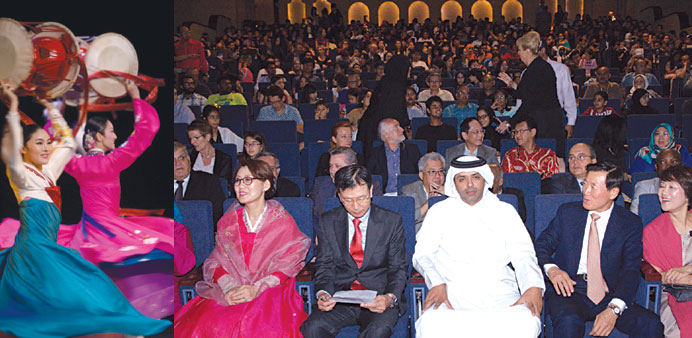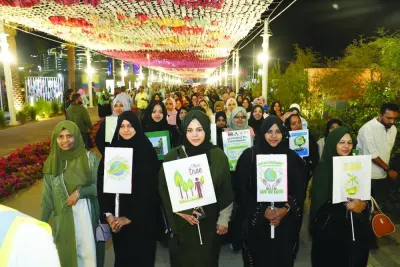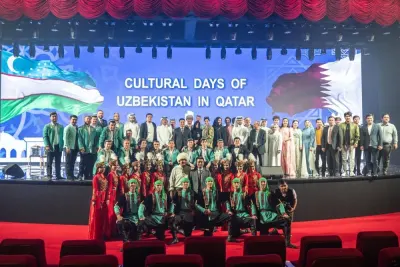A scene from the traditional drum dance
Korean and Qatari dignitaries at the eighth Korea-Arab Friendship Caravan, held in Katara.
The programme started with the Buchae-chum, a simple, yet graceful movement of Jukseon or the traditional fan made out of bamboo shoot and Hanji, the traditional Korean paper handmade from mulberry trees
By Peter Alagos
Business Reporter
The audience’s response to four Korean folk dances, which were concluded with the rhythmic beating of traditional drums and the energetic, yet graceful movements of the entire Gyeonggi Provincial Dance Company, perfectly explains what ambassador Heung-kyeong Park meant when he told Gulf Times that dance was one of the perfect tools to overcome cultural barriers.
“Dance is one of the most valuable tools to enhance understanding between two cultures,” Park said on the sidelines of the eighth Korea-Arab Friendship Caravan held at Katara – The Cultural Village yesterday.
“As the name of the event implies, we would like enhance friendship between Korea and Arab countries. These Korea-Arab societies were established because I believe that cultural activities enhance mutual understanding,” Park said.
Asked to explain how cultural dances helped strengthen international relations, Park said: “Korea and Qatar are both straightforward countries…while Koreans are hardworking people, we also find time to enjoy life and celebrate it by expressing ourselves through dance.
“Any form of dance helps overcome obstacles such as language; and this opportunity will be demonstrated by traditional and contemporary dances that we have prepared for the audience.”
According to Park, Korea has two traditional dances: the royal dance, which he described as “very aesthetic”. He added: “Our folk dance, on the other hand, is dynamic and exciting.”
The programme started with the Buchae-chum, a simple, yet graceful movement of Jukseon or the traditional fan made out of bamboo shoot and Hanji, the traditional Korean paper handmade from mulberry trees.
Incorporating the movements of the Jukseon and the Hanji into the performance was like seeing a fully-bloomed lotus flower dancing along the shallow waves that it gives ambience and warmth and elegance.
The Jindo Buk-chum, is originally part of a drum dance in Jindo Province. Unlike other regions in Korea, Jindo Province uses both sides of the drum, which enhances the effect of expressing delicate melodies and rhythms.
The third performance involved the use of the Janggu-chum, a rhythmic piece, where female dancers played various beats with the Janggu or the traditional Korean drum slung over their waist while tiptoeing and jumping across the stage in unique dance steps called Kkachi-girlum or the fast-paced steps to the beat of the drum.
The audience could not contain their excitement after watching Nongak-mu, the final. The origin of Nongak-mu can be traced back as a type of folk game in farming communities that gathered together to add some fun and muster strong spirit to their work though music. Staged folklore performances nowadays are much more common than ones in Madang, which is Korean for yard or field.
The folk dances were followed by modern break dance moves in “Marionette”, created by world-class B-Boy team, Expression Crew. Their repertoire offered an innovative and exciting experience that is unique from other B-Boy performances as it promises grand choreography harmonised with various music.
Qatar serves as the first stop of the caravan, which proceeds to Dubai on October 11 for more traditional Korean folk dances, complemented by the contemporary moves in Marrionette. The company’s final performance will be in Beirut and Tyre in Lebanon on October 14 and 15.



